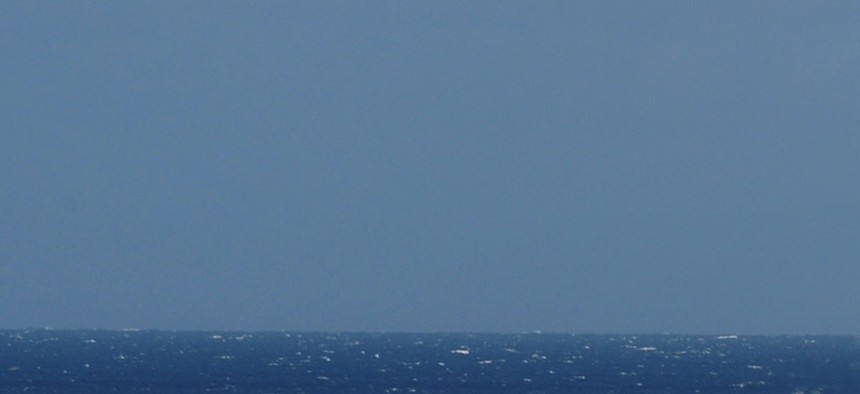
The USS Kidd, pictured above, is joining in the search efforts for the missing Malaysian Airlines flight U.S. Navy photo by Mass Communication Specialist 3rd Class Crishanda K. McCall
How the Navy's 7th Fleet Is Combing the Seas Near Malaysia for the Missing Airliner
As the search for Flight MH370 approaches its seventh day, search efforts expand westward. By Ben Watson
With U.S. intelligence and defense officials saying that terrorism remains a possible explanation for the unknown fate of Malaysian Airlines Flight MH370, nearly 40 ships and 40 aircraft from 12 different nations continue to scour the waters on either side of the Malaysian peninsula for any trace of the Boeing 777 that lost radar contact early Saturday morning over the Gulf of Thailand. Naval search efforts have turned up only occasional debris, but officials said nothing found so far is from the aircraft.
On Wednesday, Chinese government officials released images of large debris floating in the South China Sea. Those images have not led to any breakthroughs yet, and were taken in what Cmdr. William Marks, the spokesman for the U.S. Navy’s Seventh Fleet, told CNN is “not very deep water.”
The search suddenly shifted on Tuesday to the Malacca Straits, on the opposite side of the Malay Peninsula, when new radar information suggested the flight had turned around and flew hundreds of miles off course for 90 minutes with its transponder switched off. The Pentagon, so far, has not dispatched additional ships to the expanded search.
The plane was carrying 227 passengers and 12 crewmembers northeast to Beijing from Kuala Lumpur. With the fuel on board, officials said the plane — if redirected westward — couldn’t have traveled farther than India. Multinational efforts currently span an area of nearly 36,000 square nautical miles.
The Malaysian government, facing international criticism for resisting foreign offers of help, is coordinating the search, The Seventh Fleet’s Cmdr. Marks told The New York Times. “It’s like a big chessboard out there. It’s really like moving chess pieces around, and that’s 3-D. You have three dimensions, you have the water-space and the airspace.” It’s not uncommon for survivors to stay alive for three days at sea, he explained.
“The way that we in the Navy look at this is that for the first 72 hours, we consider it still a search mission for survivors,” he said. “After that, it’s at the decision of the Malaysian government what they want us to do, and where they want us to be.”
With speculation surrounding two Iranian passengers discovered to have been traveling on stolen passports, CIA Director John Brennan notably said on Tuesday that his agency was not ready to rule out terrorism, after international police leaders had suggested otherwise.
"Might it have been something that had happened inside the aircraft that led to its ultimate fate?” he asked. “Or could it have just been some type of sort of catastrophic event that unfortunately led to that aircraft’s and those passengers’ demise? I don’t know. But I don’t think people should at this point rule out any of these lines of inquiry,” Brennan said, at the Council on Foreign Relations. “This is not the time to relax, because we know there are terrorist groups that are still determined to carry out attacks, including against – especially against – aircraft.”
Malaysian investigators have described the two men as asylum seekers. One of the men, Pouria Nour Mohammed Mahread, was bound for Germany; the other, identified by Interpol as Delavar Syed Mohammed Reza, was headed for Sweden, according to a relative. “The more information we get, the more we are inclined to conclude it is not a terrorist incident,” Interpol’s Secretary General Ronald Noble told reporters on Tuesday.
U.S. surveillance satellites did not detect a midair explosion around the time the flight lost radar contact, according to several media reports. The Space Based Infrared satellite system picks up infrared signals like the heat from detonations and launches which are then archived by type. The fact that the system turned up nothing from flight MH370’s disappearance, one official said, “is particularly vexing.”
On Monday the U.S. dispatched a second guided-missile destroyer, the USS Kidd, to the region, carrying two Seahawk helicopters, the Navy’s version of Black Hawks, designed for search and rescue missions. The USS Pinckney arrived on Sunday after leaving a training mission in the South China Sea, but the Navy announced Thursday it will soon be headed to Singapore for scheduled repairs.
On Friday, one of the Navy’s P-8 Poseidon aircraft will join in the search, alternating days with a P-3C Orion surveillance aircraft, which arrived to the region over the weekend along with oiler and logistics support ship, USNS John Ericsson.
NEXT STORY: Condi Rice's Ukrainian Battle Cry